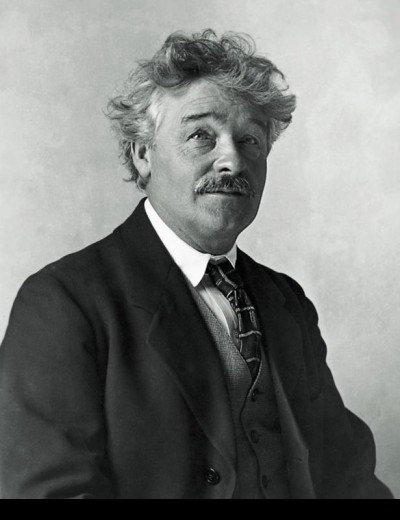
Georg Arthur Jensen
About
Georg Arthur Jensen was a Danish silversmith.
Georg Jensen was born on August 31, 1866 (the seventh of eight children) in Radvaad, Denmark, a cluster of homes around a factory north of Copenhagen in a lovely countryside. The location of Jensen's birth and early childhood was an important factor in his lifelong work which always reflected natural forms and themes from nature.
Jensen came from humble beginnings. His father was a grinder who worked in the knife factory in Radvad, these days the deer park, Dyrehaven north of Copenhagen. His mother was a housemaid and the daughter of a travelling locksmith. Jensen worked with his father at the factory from an early age and had little schooling. He was always creating things as a child and his family recognized and tried to encourage his artistic instincts. When he was 14 the family moved to Copenhagen so he could be apprenticed to a goldsmith. Apprentices worked long hours in those days and on Sundays he attended a technical school for additional training. What little spare time he had he spent modelling clay. His desire seems to have always been to become a sculptor.
From childhood, Jensen had longed to be a sculptor and he now pursued this course of study at the Royal Academy of Fine Arts. He graduated in 1892 and began exhibiting his work. Although his clay sculpture was well received, making a living as a fine artist proved difficult and he turned his hand to the applied arts. First as a modeller at the Bing & Grondahl porcelain factory and, beginning in 1898, with a small pottery workshop he founded in partnership with Christian Petersen. Again the work was well received, but sales were not strong enough to support Jensen, by this point a widower, and his two small sons.
In 1901, he abandoned ceramics and began again as a silversmith and designer with the master, Mogens Ballin. This led Jensen to make a landmark decision, when in 1904, he risked what small capital he had and opened his own little silversmithy at 36 Bredgade in Copenhagen.
Jensen's training in metalsmithing along with his education in the fine arts allowed him to combine the two disciplines and revive the tradition of the artist craftsman. Soon, the beauty and fine quality of his Art Nouveau creations caught the eye of the public and his success was assured. The Copenhagen quarters were greatly expanded and before the close of the 1920s, Jensen had opened retail outlets as far ranging as New York, London, Paris, Stockholm, and Berlin.
Georg Jensen died in 1935 in Copenhagen, but in the preceding years he imbued the firm with his strongly held ideals concerning both artistry in design and excellence in craftmanship, this tradition has been adhered to throughout the twentieth century. Although Jensen himself was a proponent of the Art Nouveau style, he had the wisdom and foresight to allow his designers their own freedom of expression which expanded the stylistic scope of what the firm produced and allowed it to keep step with time
The Look
Georg Jensen always claimed that from his early childhood, Nature was his greatest inspiration. His work certainly bears this out with the Blossom and Fuchsia flatware patterns and his vines, leaves and grape motifs in jewelry.